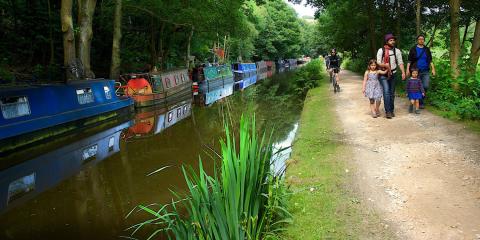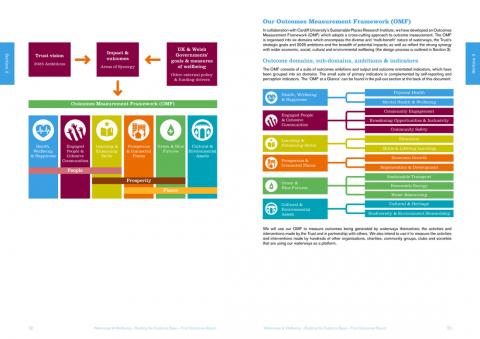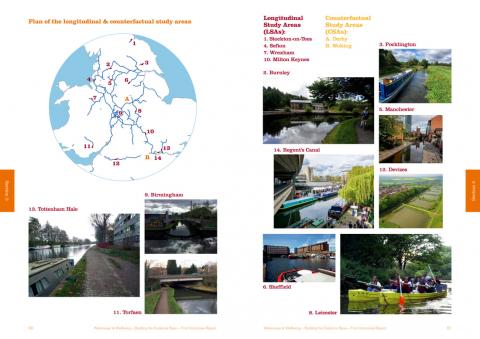Trust focuses on towpath users in bid for funding
October 2017 - As the point approaches when the Canal & River Trust could lose much or all of its Government funding – currently a quarter of its income – it is setting out to prove to politicians that it has a real value to society and that there are genuine financial reasons to keep funding it, writes Peter Underwood.
It has just launched a massive and clearly expensive piece of research carried out by a number of consultants and universities that aims to provide a means of proving it is worthy of taxpayer funds.
The report, called 'Waterways & Wellbeing, Building the Evidence Base' creates something called the Outcomes Measurement Framework (OMF) 'to measure the broad social, economic and environmental impacts that our waterways and our activities have on the communities they serve'.
The 66-page report looks at the waterways’ contribution to economic, social, cultural and environmental wellbeing in England and Wales and the things C&RT is doing 'to measure the real improvements people see in their lives thanks to canals and rivers'.
C&RT admits that it aims to 'demonstrate how we are helping to meet UK and Welsh Governments’ goals and measures for wellbeing'. The report uses the word boat or boating around 20 times in its entirety and boats are not identified as a key factor in any wellbeing measurement.
The report is the baby of Heather Clarke, C&RT Director of Strategy & Planning who says: “This is just the start, but it is a base camp from which we can climb as we build greater understanding and appreciation among policy makers, politicians, partners and funders of the positive outcomes generated by our waterways.”
She adds: “The Trust is striving to become a charity whose users and visitors are reflective of the local communities living within the waterway corridors.”
According to the report, there are three principal challenges facing the waterways and the Trust:
• being more inclusive, to attract more people from Black, Asian and Ethnic Minorities
backgrounds to visit, use and enjoy their local waterways as they are significantly underrepresented in our user and visitor population;
• re-address the age imbalance, to attract more young people and encourage greater intergenerational interaction as our current user and visitor age profile is significantly older; and
• lack of awareness of the presence of a canal or river on people’s doorstep and associated low perceptions.
The research work necessary to back up the Trusts bids for public money is substantial as it attempts to move beyond the often discredited calculations of the number of visitors to the towpaths.
It has selected fourteen sections of waterway corridors across the network to focus 'in-depth measurement and evaluation work' and is even planning to install cameras in key locations to record towpath and canal traffic using software that can distinguish between walkers, cyclists, boaters and other users.
After a trial in Manchester, C&RT concluded the deployment of automatic ‘intelligent’ video counting and analytic technology could provide it with 'a cost effective and sustainable technology for measuring different levels and types of activity on our towpaths'.
This year and next it will be installing around 50 'automatic video analytic sensors' to monitor the volume and type of towpath use in the fourteen Study Areas; and installing temperature and air quality sensing capabilities in six of the more densely populated urban Study Areas to provide accurate real-time data on airborne particulate concentration along with temperature readings.
This information will help the Trust assess the wider environmental and health benefits of off-road waterway routes in urban areas, for example, contrasting air quality and temperature of city centre areas with the waterway corridor.
The sensors are housed in self-contained boxes around the size of a shoebox but require connection to a mains supply and will be in operation for five to ten years.
The current indications that waterways make any difference to wellbeing are not encouraging. The four Office for National Statistics (ONS) measures of subjective wellbeing show waterway users appear to have only a slightly higher level of wellbeing compared to the non-waterway users.
ONS subjective wellbeing measures linked to anxiety, show waterway users appear to have the same levels of anxiety as the non-waterway users. Other results reveal that whilst there are some small differences in wellbeing scores, it is inconclusive whether being close to a waterway improves wellbeing toany significant extent, particularly when considering factors which impact more on people’s lives.
The Trust is seeking to build a national towpath model to support the measurement of physical health and sustainable transport impacts of the towpath.
C&RT also wants to measure the value attributable to waterways linked to 'regeneration, place branding and place making as well as to the resilience of place' and to estimate the amenity value that house buyers place on proximity to a waterway.
According to Nancy Hey, Centre Director at What Works Wellbeing and a guest speaker at the launch event, said: "The work that the Canal & River Trust is doing on outcomes measurement is groundbreaking. We know that access to green space and heritage activities boost wellbeing for all, but this work is showing impact beyond how we might traditionally view it.
“The approach is something that can be useful for a wide range of other organisations. Because it gives a more robust and rounded understanding of how our waterways touch our lives and communities it means that we can do more to improve the lives of people in the UK.”
C&RT says that tTo demonstrate and evidence that our waterways are ‘transforming places and enriching lives’, we recognise the necessity to measure the value of the multipurpose nature of our waterways in terms of:
• how they are being used by others as platforms for a wide range of activity;
• the difference that our activities and interventions are making to local people’s lives; and
• the contributions they are making to the economic, social, environmental and cultural wellbeing of the nation.
The press release goes on: “We are seeking to build an evidence base that supports a shift away from traditional and narrow perspectives of waterways towards a wider recognition in policy terms, that truly reflects the cross-cutting nature of waterways’ contribution to wellbeing in its widest sense.”
It seems a shame that C&RT isn't planning to focus on the impact that boats have on people's perceptions of the canals and even their sense of wellbeing - whatever that is.
You can download the full report or summary .pdf from the CRT website here.
Photos: (1st) Trust focuses on towpath users in bid for funding, (2nd) The cover of the report, (3rd) C&RT's 'measurement framework', (4th) The spots C&RT will be monitoring with intelligent cameras.









